Maybe you don’t have much yard space, or maybe you don’t need a bushel of berries, or maybe you don’t want to invest in a trellis support structure.
By tying the berry canes of a single plant onto a stake you make the bush’s footprint smaller — you can even grow it in a half wine barrel — and make the harvesting easier. And the maintenance time required for this style amounts to around an hour per year, in my experience.
I just did that maintenance on my boysenberry bush (boysenberries being a type of blackberry, in terms of growth habit) that I have been growing on a stake for the past few years. In this post, I’ll run through the process I followed and the reasons for each step. I also grow some raspberries on a stake so I’ll show what I do for them too.
One hour of maintenance per year
At this time of year (late September) cane berries look ragged. Here was my boysenberry bush a few days ago:
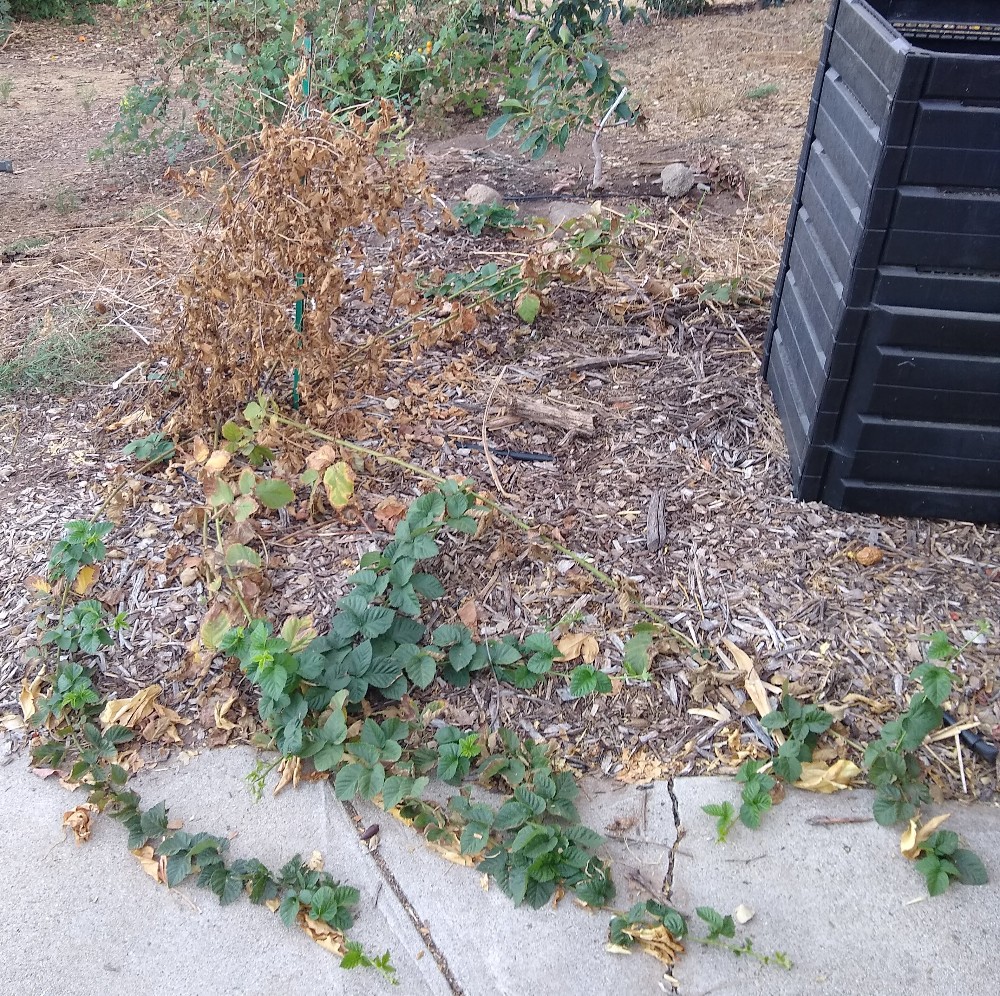
The canes on which they bore berries in June have now died back, and the canes on which they will bear berries next year have grown long and spread across the ground. Time to tidy up.
First, cut out those dead canes.
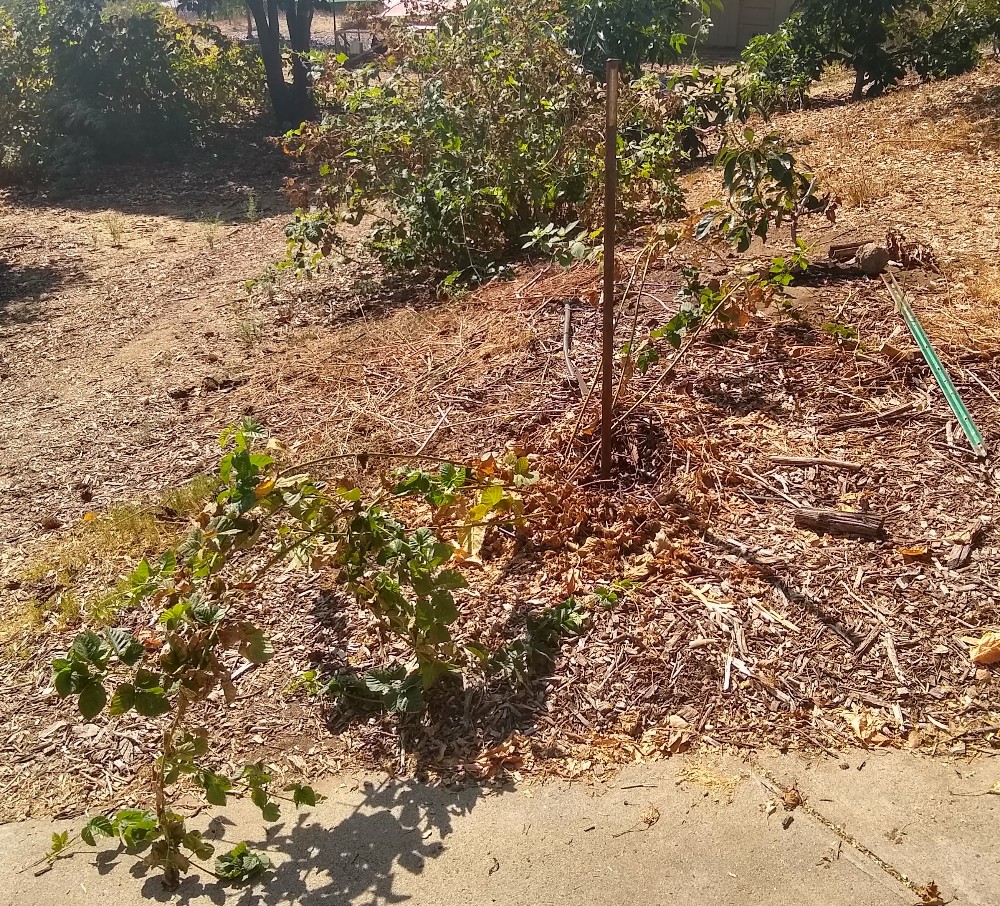
And then tie the new canes onto the stake.
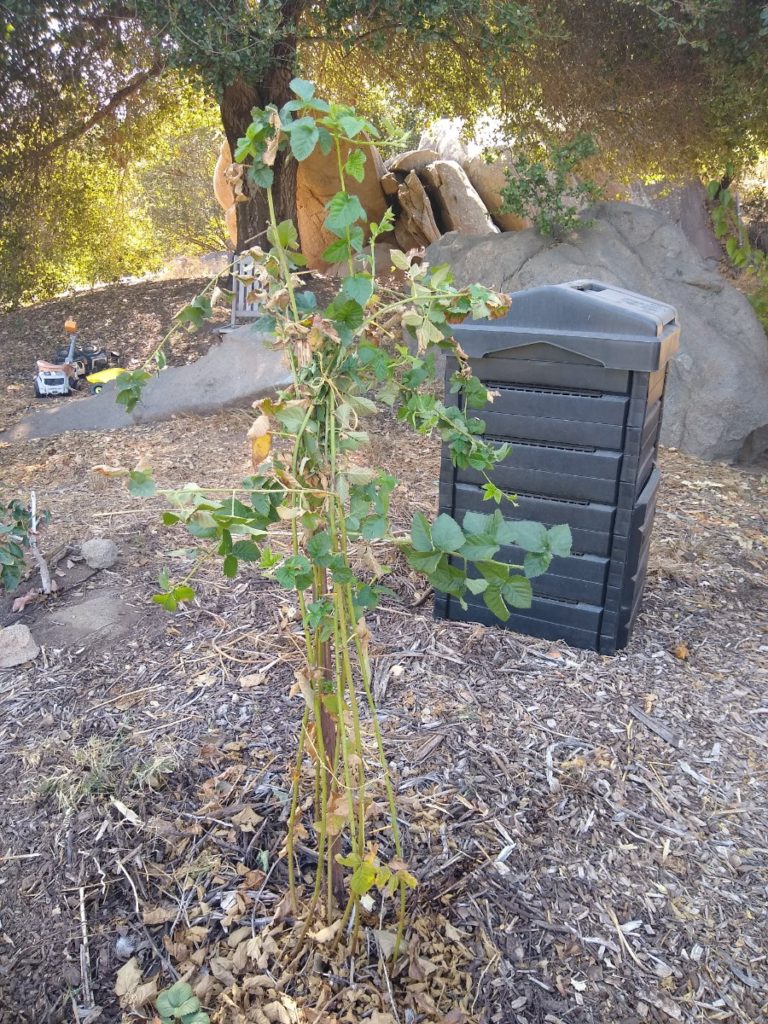
Ease of harvest
When the canes are tied onto the stake, their berries are extremely easy to harvest. Not only are they up off the ground — as with any support structure — but they are also accessible from all sides. It’s like a column of berries.
Also, to an extent, you can adjust how high those berries are produced by tying the canes to a shorter or taller stake.
Here is how the bush looked at the start of harvest this June after having pruned and tied up the canes last year the same as I just did (note the new canes already growing out at the base for next year’s berry production):
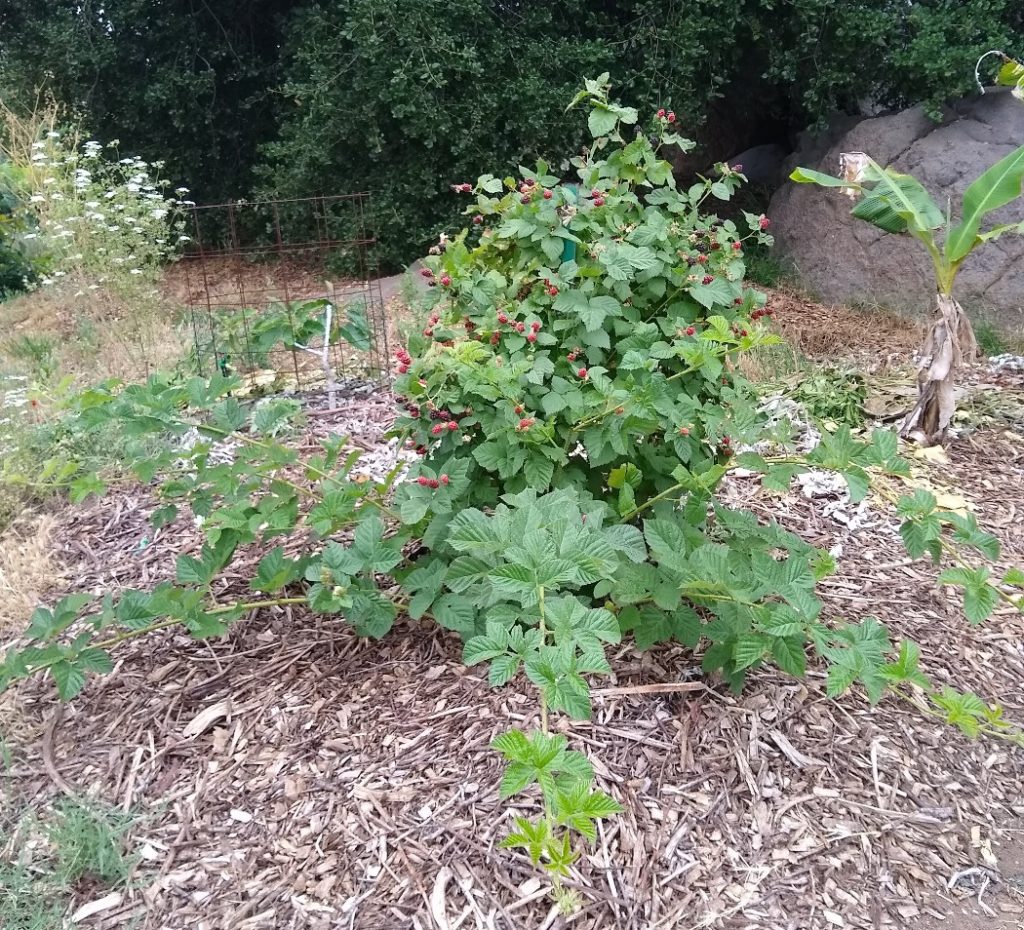
And here is how the harvesting looked:
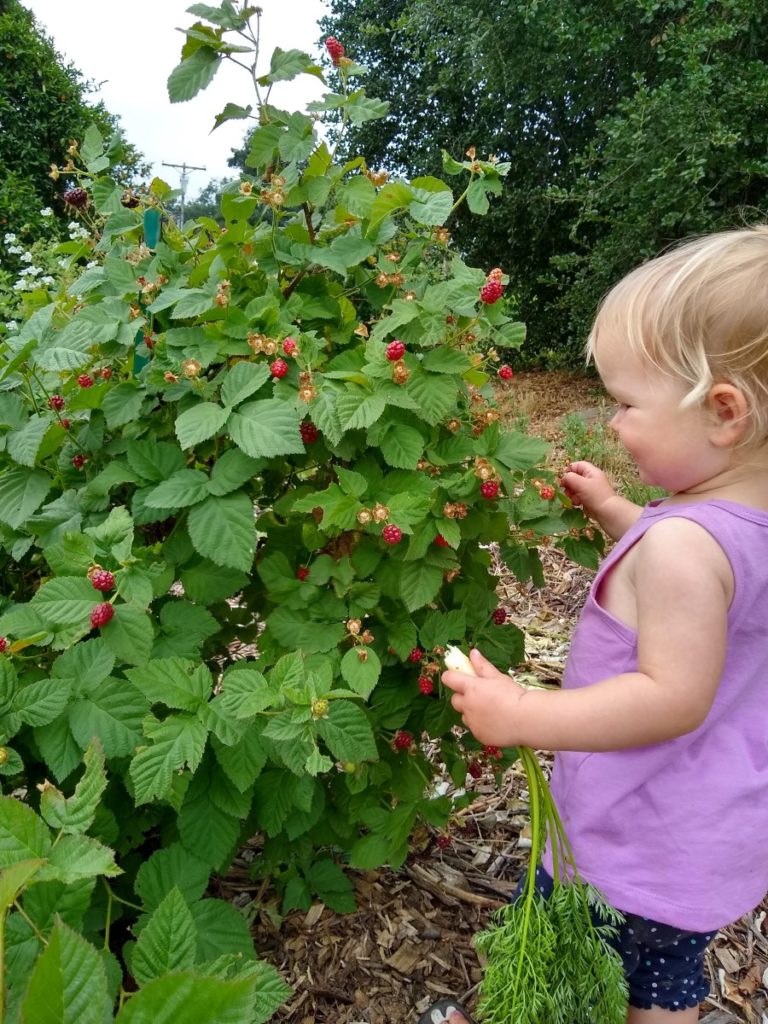
Raspberries on a stake
I have a large raspberry patch, but I also grow a single raspberry plant on a stake. Caring for this raspberry plant is slightly different than for the boysenberries because raspberries grow slightly differently than boysenberries and most blackberries.
Here in the early fall, I cut out any dead canes — just like on the boysenberry — but I also cut back any dead ends of live canes. Raspberries, unlike most blackberries, flower and fruit a second time in the fall. Look for new growth emerging part way down the cane and cut back to there.
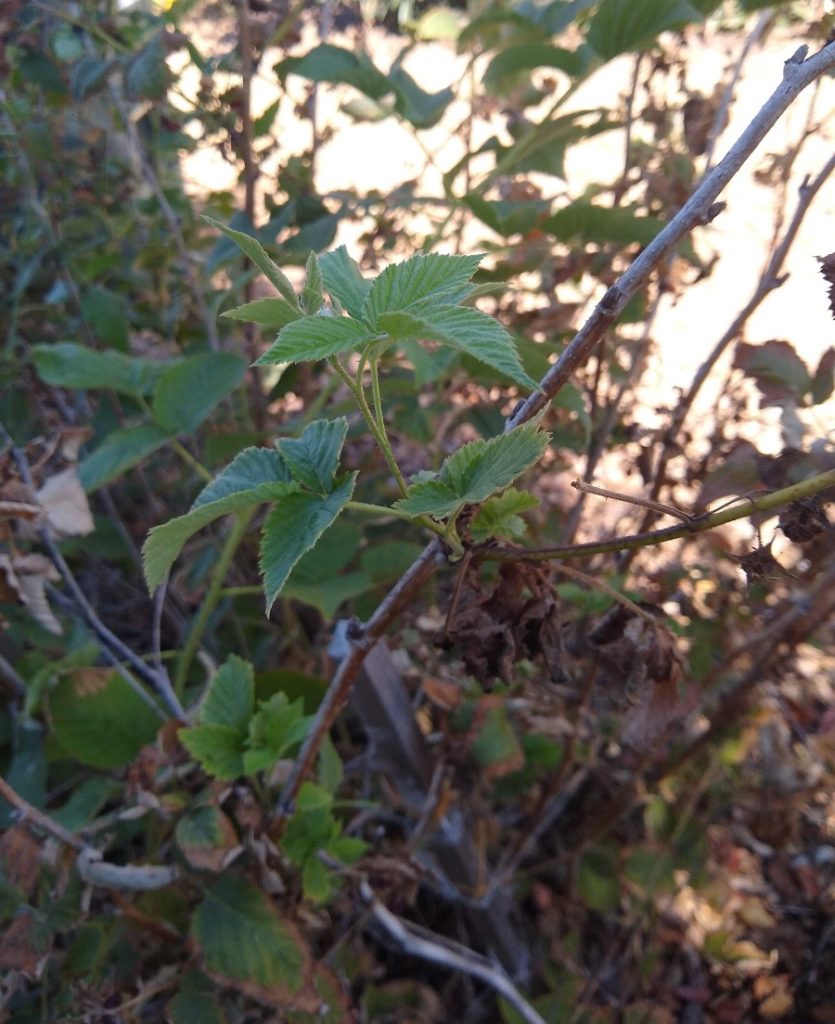
This isn’t necessary maintenance. The canes will make berries in the fall regardless of whether you cut off their dead ends. But I do it because it makes harvest easier when you remove those dead ends.
After the pruning, I pull up any shoots that have sprouted up outside the area I designated for this bush. Raspberries send up shoots from their roots so you have to put on a glove and pull these shoots out or else your bush will spread over a wider and wider area.
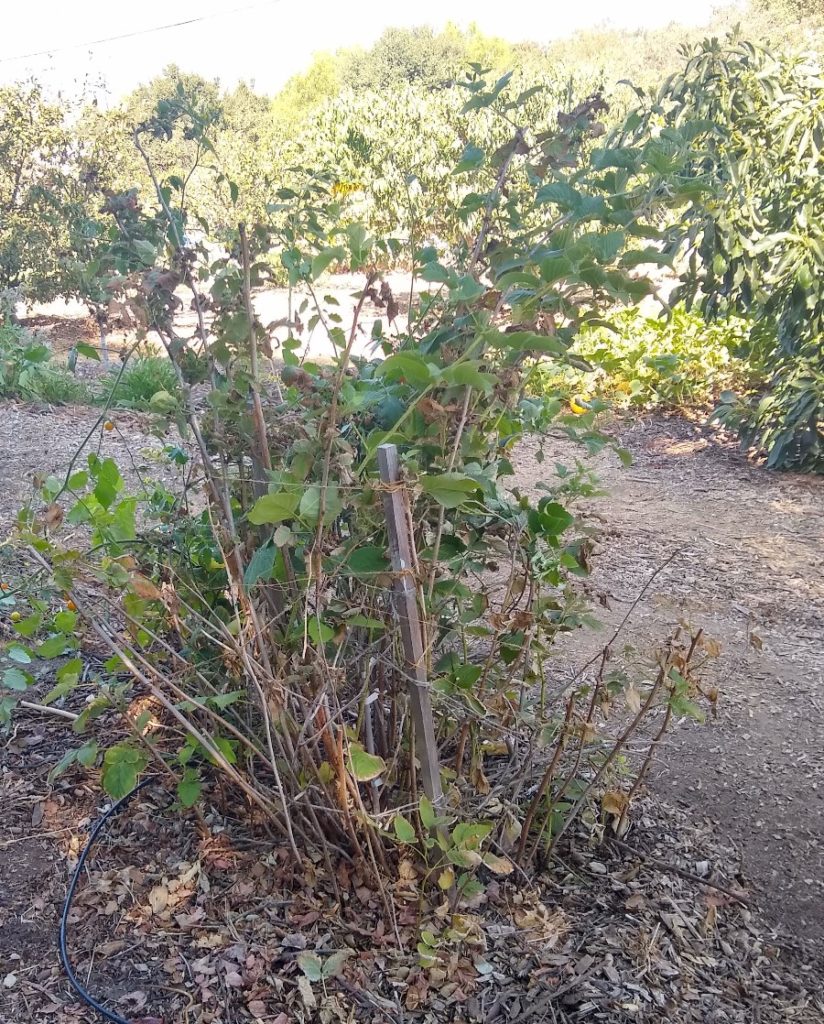
Finally, I retie the canes around the stake with jute twine so they stand more erect and are easier to harvest. Tying raspberries up is not as necessary as with many blackberry varieties because raspberries usually stand up well on their own. It still helps to make harvest easier though.
One more time in the late winter I go through the same quick maintenance procedure with these raspberries, where I cut out dead canes, pull up shoots that are out of bounds, and retie the canes as necessary. Total maintenance time for both the end of summer and late winter sessions is roughly an hour.
In June, just before harvest started, the plant looked like this:

That’s how I grow small blackberry and raspberry bushes on stakes. In fact, these bushes are maintained so small that I’ve realized that I can fit another plant in between them so this summer I planted a new raspberry of a different variety — that I will also keep small and make the harvest easy by tying up around a stake.
You might also like to read my general post about growing raspberries in Southern California.
And all of my Yard Posts can be found HERE.




As luck would have it, I am making my blackberry patch this weekend! How far apart using this method do you recommend the blackberry bushes. These are the thornless black diamond plants. For watering, I was going to snake a netafim drip line through the patch(lazy method), or create tree rings of the netafim on each bush. Perfect timing on the post.
Great timing, Annette! I walked mine off, and I would put them at least three steps apart if you want to be able to easily walk between them at harvest time.
Mine are also on drip. My larger raspberry patch has a couple lines snaked through it just as you described whereas my plants on stakes have rings around them. I like having the blackberries on drip because it discourages them from rooting when their cane tips touch the ground (as there’s usually no moisture to root into).
Thanks for your post Greg. I am in the Ventura County area – would you recommend buying raspberries from say “Bay Laurel Nursery” or other out of area reseller or would you look locally?
Hi Richard,
That’s a good question. In my own limited experience, I haven’t noticed a significant difference in the performance of raspberries purchased locally versus from out of the area. I’m sure there are varieties that perform better in different climates. But I haven’t noticed the marketing information about such varieties being so reliable.
For example, Bababerry is said to be great for areas with hot summers and mild winters, but mine hasn’t performed any better in my location (Ramona, inland San Diego County) than the raspberry plants of an unknown variety that I brought down from Oregon.
So I would try to buy locally just to support local nurseries, but I wouldn’t expect to necessarily get better-performing raspberry varieties from a local reseller compared to a vendor from out of the area.
This reminds me that some years back a former Cooperative Extension advisor here in San Diego County recommended as his favorite raspberry variety for the area one called Oregon 1030. As I recall, he said it was originally found growing in Corvallis. (My memory could be wrong here though.) I grew some of the plants he gave me and they did well, but that was in a previous garden only a couple miles from the ocean.
Hi! I just found a few berries in a bush that I thought was a pretty weed on the side of my house. We’ve gotten lotsss of rain lately out in Clovis, NM. This is my first spring/summer here, I have lots of random plants that I have no idea what they are until I see a flower lol! Now that I finish this comment I was hoping I could add a photo of my berry bush to help identify. Lol
Hi Greg, my name is Jeff I’m in Huntington Beach/ Fountain Valley border . My Blackberry plant my son I grew was and / is huge , It’s still green without berries but looks like they’re turning purple on outside of leaves now Should I cut them back yet ? Or wait until they die out above ground . Frost is rare here . I had first year of fruit this last spring and had great results without knowing much about berries. Then do trellis ( Im a carpenter and can build anything ) Also when do you recommend we cut them back now in mid October ?
Thanks ! Love all of your great opinions and knowledge here .
Jeff
Hi Jeff,
Thanks! For maximum berry production, I’d wait until they die back. That way you know you’re cutting out canes that won’t be producing berries in the spring. But if some of the canes are too long and you want to reduce the size of the bush, then cut those out anytime, including here in mid-October.
I dug up some heavily producing plants from a neighbors house and planted them in a rich garden bed. They grew green vines over 20 feet this summer but no fruit.They were all green , full of leaves and healthy. I just cut all the vines off and was thinking of replanting thick canes from these vines as new plants. Does that work and what did I do wrong to get no fruit ? Confused about growing boysenberries.
Hi Bita,
Most likely, those long green canes that grew this summer would have flowered and fruited this coming spring. Each boysenberry cane lives for two years: the first year it grows but does not flower; the second year it flowers and fruits.
Aww. I’m sad I cut them up but it was like an unruly octopus that took over. They were on top of structure and the whole garden. I’ll try again in a permanent spot and have patience this time now that I know. Thanks for the help
Hi Greg!
This was helpful. I planted them. 2 raspberries on one good sun area… and two blackberries and a raspberry on the other good sun spot. The blackberries are super small. Do we add a post now? Or what till they grow up a little? You mentioned you will add a larger post in the article. Is there danger of damaging the roots when I add each taller size?
How long do you run the drip system. I live inland with summer heat reaching to 100+ degrees and mild winters.